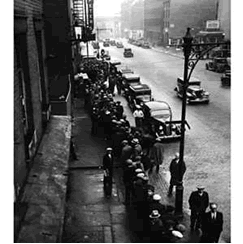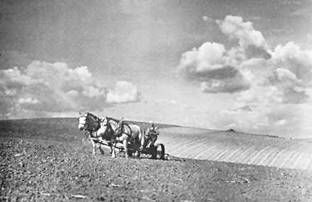Great Depression in the United States
reat Depression in the United States , worst and longest economic collapse in the history of the modern industrial world, lasting from the end of 1929 until the early 1940s. Beginning in the United States , the depression spread to most of the world's industrial countries, which in the 20th century had become economically dependent on one another. The Great Depression saw rapid declines in the production and sale of goods and a sudden, severe rise in unemployment. Businesses and banks closed their doors, people lost their jobs, homes, and savings, and many depended on charity to survive. In 1933, at the worst point in the depression, more than 15 million Americans—one-quarter of the nation's workforce—were unemployed.

The Great Depression forced many Americans to go hungry or depend on charities for food, clothing, and other necessities. Here, people wait in a breadline to receive free food.
The depression was caused by a number of serious weaknesses in the economy. Although the 1920s appeared on the surface to be a prosperous time, income was unevenly distributed. The wealthy made large profits, but more and more Americans spent more than they earned, and farmers faced low prices and heavy debt. The lingering effects of World War I (1914-1918) caused economic problems in many countries, as Europe struggled to pay war debts and reparations. These problems contributed to the crisis that began the Great Depression: the disastrous U.S. stock market crash of 1929, which ruined thousands of investors and destroyed confidence in the economy. Continuing throughout the 1930s, the depression ended in the United States only when massive spending for World War II began.
The depression produced lasting effects on the United States that are still apparent more than half a century after it ended. It led to the election of President Franklin Delano Roosevelt, who created the programs known as the New Deal to overcome the effects of the Great Depression. These programs expanded government intervention into new areas of social and economic concerns and created social-assistance measures on the national level. The Great Depression fundamentally changed the relationship between the government and the people, who came to expect and accept a larger federal role in their lives and the economy.
The programs of the New Deal also brought together a new, liberal political alliance in the United States . Roosevelt 's policies won the support of labor unions, blacks, people who received government relief, ethnic and religious minorities, intellectuals, and some farmers, forming a coalition that would be the backbone of the Democratic Party for decades to come.

The history of farming in Nebraska is tainted by droughts and pestilence, but the Great Depression had the most damaging effect on farmers and their families. This 1936 photograph records a farmer at his plow in Lancaster County in southeastern Nebraska .
On a personal level, the hardships suffered during the depression affected many Americans' attitudes toward life, work, and their community. Many people who survived the depression wanted to protect themselves from ever again going hungry or lacking necessities. Some developed habits of frugality and careful saving for the rest of their lives, and many focused on accumulating material
possessions to create a comfortable life, one far different from that which they experienced in the depression years.
The depression also played a major role in world events. In Germany , the economic collapse opened the way for dictator Adolf Hitler to come to power, which in turn led to World War II.